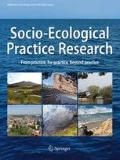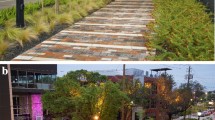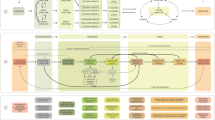Abstract
Ian McHarg’s ecological planning method has been influential since the publication of Design with Nature in 1969. However, less is known about McHarg’s pioneering contributions to landscape performance evaluation, which are critical in today’s practice. After a review of McHarg’s theoretical foundation and interdisciplinary design process, we suggest that McHarg’s method facilitates the function of environmental performance, because planning goals, including performance benchmarks, are integral parts of the design process. In addition, we respond to the misconception of McHarg’s disinterest in social and economic factors, through a review of three exemplary projects—Interstate 95 in New Jersey, Medford Township, and The Woodlands—all of which illustrated salient, multifaceted benefits. Last, we synthesize the policy and practical implications of landscape performance evaluation (e.g., environmental impact assessment) that enrich McHarg’s theory and actionable planning process toward sustainability. We conclude that McHarg is a forerunner in landscape performance evaluation. Through blending project goals and performance goals, McHarg’s method improves project performance and increases the validity of ecological planning.




Image courtesy: Creative Resource Systems, Winterville, NC



Similar content being viewed by others
References
Appleton AF (2012) The Staten Island Bluebelt: a study in sustainable water management. Institute for Sustainable Design. http://cooper.edu/isd/news/waterwatch/statenisland. Accessed 10 Mar 2018
Bass RE, Herson AI, Bogdan KM (2001) The NEPA book: a step-by step guide on how to comply with the National Environmental Policy Act. Solano Press Books, Point Arena
Bedient P, Flores A, Johnson S, Pappas P (1985) Floodplain storage and land use analysis of The Woodlands, Texas. Water Resource Bull 21(4):543–552
Calkins M (2012) The sustainable sites handbook: a complete guide to the principles, strategies, and best practices for sustainable landscapes. Wiley, New York
Canfield J, Yang B, Whitlow H (2019) Landscape performance guidebook: a guide for metric selection. Landscape Architecture Foundation, Washington DC
Cohen WJ (2003) A critical assessment of Ian McHarg’s human ecological planning curriculum at the University of Pennsylvania. Penn Dissertation (AAI3087385). https://repository.upenn.edu/dissertations/AAI3087385. Accessed 21 Feb 2019
Cohen WJ (2019) Ecohumanism and the ecological culture: the educational legacy of Lewis Mumford and Ian McHarg. Temple University Press, Philadelphia
Corbett J (2001) Ian McHarg, overlay maps and the evaluation of social and environmental costs of land use change. CSISS Classics. https://escholarship.org/uc/item/5x78n2gn. Accessed 15 Jan 2019
Culbertson KD (2011) Research priorities. Landscape Archit Mag 101:235
Daniels T (2019) McHarg’s theory and practice of regional ecological planning: retrospect and prospect. Socio Ecol Pract Res. https://doi.org/10.1007/s42532-019-00024-4
Domlesky A (2018) Incubating innovation in practice: research models from architecture, engineering, and landscape architecture. Landsc Archit Front 6(5):121–129
Doubleday G, Sebastian A, Luttenschlager T, Bedient PB (2013) Modeling hydrologic benefits of low impact development: a distributed hydrologic model of The Woodlands, Texas. J Am Water Resour Assoc 49(6):1444–1455
Eisenman T (2005) A watershed moment in green infrastructure: on Staten Island, a pioneering stormwater project uses natural systems. Landsc Archit Mag 95(11):56–63
Eugster JG (2003) Evolution of the heritage areas movement. George Wright Forum 20(2):50–59
Evans MT (2015) Main street, America: histories of I-95. University of South Carolina—Columbia Doctoral dissertation. https://scholarcommons.sc.edu/etd/3223. Accessed 1 Jul 2019
Feuer A (2014) Building for the next big storm after hurricane Sandy, New York rebuilds for the future. New York Times. https://www.nytimes.com/2014/10/26/nyregion/after-hurricane-sandy-new-york-rebuilds-for-the-future.html. Accessed 10 Mar 2018
Fleming B (2017) The real villains in Harvey flood: urban sprawl and the politicians who allowed it. The guardian. https://www.theguardian.com/commentisfree/2017/aug/31/real-villains-harvey-flood-urban-sprawl. Accessed 2 Sept 2017
Forman RT (2002) The missing catalyst: design and planning with ecology roots. In: Johnson B, Hill K (eds) Ecology and design: frameworks for learning. Island Press, Washington, DC, pp 85–109
Forsyth A (2002) Planning lessons from three US new towns of the 1960 and1970: Irvine, Columbia, and The Woodlands. J Am Plan Assoc 68(4):387–415
Forsyth A (2003) Ian McHarg’s Woodlands: a second look. Plan Chicago 69(8):10–13
Forsyth A (2005) Reforming Suburbia: the planned communities of Irvine, Columbia, and The Woodlands. University of California Press, Berkeley/Los Angeles
Galatas R, Barlow J (2004) The Woodlands: the inside story of creating a better hometown. Urban Land Institute, Washington DC
Giliomee JH (1977) Ecological planning: method and evaluation. Landsc Plan 4:185–191
Gold AJ (1974) Design with nature: a critique. J Am Inst Plan 40(4):284–286
Gumb D, Garin J, Mehrotra S, Henn B (2007) Watershed approach to integrating green and hard infrastructure: the Staten Island Bluebelt. https://www.hazenandsawyer.com/publications/watershed-approach-to-integrating-green-and-hard-infrastructure/. Accessed 10 Mar 2018
Gumb D, Garin J, Mehrotra S, Henn B (2008) Watershed approach to integrating green and hard infrastructure: New York city’s Staten Island Bluebelt. Proc Water Environ Fed 6:951–958
Gumb D, Rossi J, Mehrotra S, Deb D, Henn B (2009) The Staten Island Bluebelt: a case study in urban stormwater management. http://documents.irevues.inist.fr/bitstream/handle/2042/25201/0019_262gumb.pdf?sequence=1. Accessed 10 Mar 2018
Heavers N (2019) Ian McHarg’s enduring influence on the ecological planning and design of Washington’s waterfront. Socio Ecol Pract Res. https://doi.org/10.1007/s42532-019-00015-5
Herrington S (2010) The nature of Ian McHarg’s science. Landsc J 29(1):1–20
Holden C (1977) Ian McHarg: champion for design with nature. Science 195(4276, 28 January):379–382
Hough M (1984) City form and natural process. Routledge, London
John-Alder K (2014) Processing natural time: Lawrence Halprin and the Sea Ranch ecoscore. Stud Hist Gard Des Landsc 34(1):52–70
Johnson AH, Berger J, McHarg I (1979) A case study in ecological planning: The Woodlands, Texas. In: McHarg I, Steiner F (eds) (1998) To heal the earth: selected writings of Ian L. McHarg. Island Press, Washington DC, pp 42–263
Jost D (2012) The measured response. Landsc Archit Mag 102(3):92–103
Juneja N (1974) Medford: performance requirements for the maintenance of social values represented by the natural environment of Medford Township New Jersey. Center for Ecological Research in Planning and Design, University of Pennsylvania, Philadelphia
Juneja N, Veltman J (1980) Natural drainage in The Woodlands. Stormwater management alternatives. Water Resources Center, University of Delaware, Newark, pp 143–157
Kendig L (1980) Performance zoning. Planners Press, American Planning Association, Washington DC
Kendig L, Keast B (2010) Community character: principles for design and planning. Island Press, Washington DC
Kim J, Ellis CD (2009) Determining the effects of local development regulations on landscape structure: comparison of The Woodlands and North Houston, TX. Landsc Urban Plan 92(3):293–303
Kutchin J (1998) How mitchell energy & development corp. got its start and how it grew. Mitchell Energy & Development Corporation, The Woodlands
Landscape Architecture Foundation (LAF) (2011) https://lafoundation.org/. Accessed 5 Sept 2011
Lee BJ (1982) An ecological comparison of the McHarg method with other planning initiatives in the Great Lakes Basin. Landsc Plan 9:147–169
Leonard R (2013) DW legacy design® work. Archit Worlds 154:88–95
Lyle J (1999) Design for human ecosystems: landscape, land use, and natural resources. Island Press, Washington, DC
Margulis L, Corner J, Hawthorne B (2007) Ian McHarg/dwelling in nature: conversations with students. Princeton Architectural Press, New York
McCoy E, Braco M, Mandel L (2018) A landscape performance + metrics primer for landscape architects: measuring landscape performance on the ground. American Society of Landscape Architects, Washington, DC
McHarg IL (1967) Where should highways go? Comprehensive route selection method gets most social benefit at least social cost. Landsc Archit Mag 57:179–181
McHarg IL (1968) A comprehensive highway route-section method. Highw Res Rec 246:1–15
McHarg IL (1969) Design with nature. Doubleday/Natural History Press, Garden City
McHarg IL (1996) A quest for life: an autobiography. Wiley, New York
McHarg IL, Steiner FR (eds) (1998) To heal the earth: selected writings of Ian L. McHarg. Island Press, Washington DC
McHarg IL, Steiner FR (eds) (2006) The essential Ian McHarg: writings on design and nature. Island Press, Washington DC
McHarg IL, Sutton J (1975) Ecological plumbing for the Texas coastal plain: The Woodlands new town experiment. Landsc Archit Mag 65(1):80–90
Mendenhall A (2016) Place value: empowering landscape architects to measure the economic benefits of designed landscapes. Land 8: landscape architects network. https://land8.com/place-value-empowering-landscape-architects-to-measure-the-economic-benefits-of-designed-landscapes/. Accessed 5 July 2019
Morgan GT, King JO (1987) The Woodlands: new community development 1964–1983. Texas A&M University Press, College Station
Ndubisi F (2002) Ecological planning: a historical and comparative synthesis. Johns Hopkins University Press, Baltimore
Ndubisi F (2008) Sustainable regionalism: evolutionary framework and prospects for managing metropolitan landscapes. Landsc J 27(1):51–68
Ndubisi F (2014) The ecological design and planning reader. Island Press, Washington DC
Ndubisi F (2016) Adaptation and regeneration: a pathway to new urban places. In: Steiner F, Thompson G, Carbonell A (eds) Nature and cities: the ecological imperative in urban design and planning. Lincoln Institute of Land Policy, Cambridge, pp 191–211
Palmer AE (1981) Toward Eden. Creative Resource Systems, Winterville
Simon HA (1983a) Models of bounded rationality: economic analysis and public policy, vol 1. MIT Press, Cambridge
Simon HA (1983b) Models of bounded rationality: behavioral economics and business organization, vol 2. MIT Press, Cambridge
Spirn AW (1984) The granite garden: urban nature and human design. Basic Books, New York
Spirn AW (1985) Urban nature and human design: renewing the great tradition. J Plan Educ Res 5(1):39–51
Spirn AW (2000) Ian McHarg, landscape architecture, and environmentalism: ideas and methods in context, pp 97–114. Environmentalism in landscape architecture (Dumbarton Oaks colloquium on the history of landscape architecture), vol 22. Dumbarton Oaks, Washington DC
Steiner FR (2004) Healing the earth: the relevance of Ian McHarg’s work for the future. Philos Geogr 7(1):141–149
Steiner FR (2008) The living landscape: an ecological approach to landscape planning, 2nd edn. Island Press, Washington DC
Steiner FR (2011) Design for a vulnerable planet. University of Texas Press, Austin
Steiner FR (2017) Healing the earth: the relevance of Ian McHarg’s work for the future. Hum Ecol Rev 23(2):75–85
Steiner FR (2018) Making plans: how to engage with landscape, design, and the urban environment. University of Texas Press, Austin
Steiner FR (2019) Toward an ecological aesthetic. Socio Ecol Pract Res. https://doi.org/10.1007/s42532-018-00004-0
Steiner FR, Fleming B (2018) Design with nature at 50: retrospect and prospect special issue call for papers. Socio Ecol Pract Res. http://static.springer.com/sgw/documents/1640016/application/pdf/A+Call+for+special+issue+contributions_Design+with+Nature+at+50+Retrospect+and+Prospect.pdf. Accessed 15 Jan 2019
Steiner FR, Osterman DA (1998) Landscape planning: a working method applied to a case study of soil conservation. Landsc Ecol 1(4):213–226
Steiner FR, Young G, Zube E (1988) Ecological planning: retrospect and prospect. Landsc J 7(1):31–39
Sung CY (2013) Mitigating surface urban heat island by a tree protection policy: a case study of The Woodland, Texas, USA. Urban For Urban Green 12:474–480
The Woodlands Township (2011) Parks and recreation needs assessment. The Woodlands Township, The Woodlands
Thompson GF, Steiner FR (1997) Ecological design and planning. Wiley, New York
Wallace DA (ed) (1970) Metropolitan open space and natural process. University of Pennsylvania Press, Philadelphia
Wallace, McHarg, Roberts and Todd (1976) Environmental resources of the Toronto Central Waterfront. Central Waterfront Planning Committee, Toronto
Wallace, McHarg, Roberts and Todd (WMRT) (1965) A comprehensive highway route selection method applied to I-95 between the Delaware and Raritan rivers. Wallace, McHarg, Roberts and Todd, Philadelphia
Wallace, McHarg, Roberts and Todd (WMRT) (1973a) Woodlands new community: guidelines for site planning. Wallace, McHarg, Roberts and Todd, Philadelphia
Wallace, McHarg, Roberts and Todd (WMRT) (1973b) Woodlands new community: phase one—land planning and design principles. Wallace, McHarg, Roberts and Todd, Philadelphia
Wallace, McHarg, Roberts and Todd (WMRT) (1973c) Woodlands new community: an ecological inventory. Wallace, McHarg, Roberts and Todd, Philadelphia
Wallace, McHarg, Roberts and Todd (WMRT) (1974) Woodlands new community: an ecological plan. Wallace, McHarg, Roberts and Todd, Philadelphia
Wang X, Palazzo D, Carper M (2016) Ecological wisdom as an emerging field of scholarly inquiry in urban planning and design. Landscape Urban Plan 155:100–107
Weller R, Talarowski M (2014) Transects: 100 years of landscape architecture and regional planning at the school of design of the University of Pennsylvania. Applied Research+ Design
Whitlow H, Canfield J, Yang B (2019) Evaluating performance: guide to metrics. In: Presentation at 2019 council of educators in landscape architecture conference, March 6–9, 2019, Sacramento
Workshop Design (2007) Toward legacy. Grayson Publishing, Washington DC
Xiang WN (2016) Ecophronesis: the ecological practical wisdom for and from ecological practice. Landsc Urban Plan 155:53–60
Xiang WN (2017) Pasteur’s quadrant: an appealing ecophronetic alternative to the prevalent Bohr’s quadrant in ecosystem services research. Landsc Ecol 32:2241–2247
Xiang WN (2019a) Ecopracticology: the study of socio-ecological practice. Socio Ecol Pract Res 1(1):7–14
Xiang WN (2019b) History voted many times in Ian McHarg’s favor. Socio Ecol Pract Res 1:165–169
Xiang WN (2019c) Ian McHarg and “the ecology of the city”. Socio Ecol Pract Res 1:163–164
Yang B (2018) Landscape performance: Ian McHarg’s ecological planning in The Woodlands. Routledge, Texas
Yang B, Li M-H (2010) Ecological engineering in a new town development: drainage design in The Woodlands, Texas. Ecol Eng 36(12):1639–1650
Yang B, Li M-H (2011) Assessing planning approaches by watershed streamflow modeling: case study of The Woodlands, Texas. Landsc Urban Plan 99(1):9–22
Yang B, Li S-J (2013) Green infrastructure design for stormwater runoff and water quality: empirical evidence from large watershed-scale community developments. Water 5:2038–2057
Yang B, Li S-J (2016) Design with Nature: Ian McHarg’s ecological wisdom as actionable and practical knowledge. Landsc Urban Plan 155:21–32
Yang B, Li M-H, Li S-J (2013) Design-with-nature for multifunctional landscapes: environmental benefits and social barriers in community development. Int J Environ Res Public Health 10(11):5433–5458
Yang B, Li M-H, Huang C-S (2015) Ian McHarg’s ecological planning in The Woodlands: lessons learned after four decades. Landsc Res 40(7):777–798
Zhang M, Yi C (2006) Cul-de-sac versus grid: comparing street connectivity and pedestrian accessibility of urban forms in Houston metropolitan area. Transportation research board 85th annual meeting (no. 06-1547)
Acknowledgements
The authors thank the gracious support provided by Professor William J. Cohen at Temple University. Comments and suggestions from the anonymous reviewers are also greatly appreciated.
Author information
Authors and Affiliations
Corresponding author
Rights and permissions
About this article
Cite this article
Yang, B., Li, S. Blending project goals and performance goals in ecological planning: Ian McHarg’s contributions to landscape performance evaluation. Socio Ecol Pract Res 1, 209–225 (2019). https://doi.org/10.1007/s42532-019-00029-z
Received:
Accepted:
Published:
Issue Date:
DOI: https://doi.org/10.1007/s42532-019-00029-z




